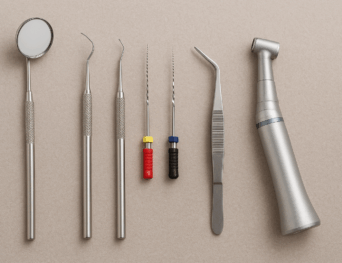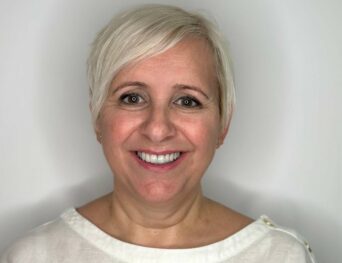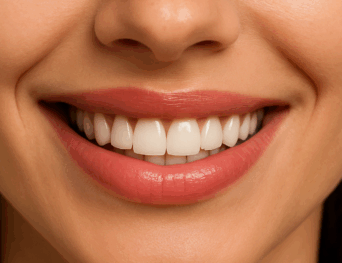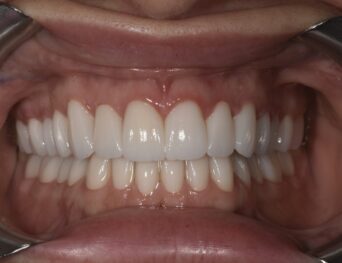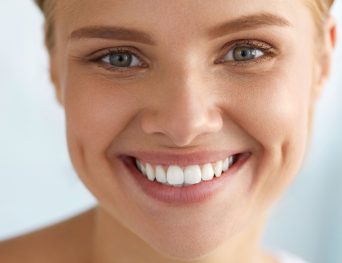Dental Prostheses
Prosthodontics is the branch of Dentistry that studies the rehabilitation of our jaws when we lose teeth, in order to return to our mouth, the correct functionality and aesthetics that are lost concomitantly with the loss of teeth. At the Dávalos & Balboa Dental Clinic, in Murcia, we give special importance to the dental prosthesis, its shape, structure, position and aesthetics.
When we lose a tooth, the adjacent teeth and those of the antagonistic archway move towards the free space causing all kinds of imbalances in the dental arches and in the masticatory function. These dental migrations cause overturning of the teeth towards the free space that cause axiality to be lost in the forces absorbed by the teeth, which harms them periodontally (worse absorption of forces and functional imbalances). In addition, with the dental loss, a process of resorption of the alveolar bone begins (the bone where the roots of the teeth are implanted and whose primary function is the maintenance of the teeth), because in the mouth, as in the rest of the organism, the function makes the organ, so that if pieces are missing, the supporting bone of these pieces is lost with them. Bone resorption occurs both horizontally (bone width), and vertically (bone height), progressively leading to bone atrophy of the alveolar apophyses in the maxillary bones. This is especially important for rehabilitation with prostheses on teeth and implants because it involves a series of aesthetic and functional complications that are difficult to solve, and more complex when the number of missing teeth is increased and the time elapsed since the loss of those teeth.
To restore the masticatory, aesthetic and phonetic functions, and minimize the previously described spring effects and the movement of the rest of the pieces towards the edentulous spaces, it is necessary to rehabilitate the arcades with the help of dental prostheses. A dental prosthesis can be performed to replace 1 tooth, 2 teeth, 3 teeth, and so on up to all the teeth of one or both arches. It can be supported by implants (implant-supported prosthesis), by teeth (fixed prosthesis on teeth) or muco-supported (removable prostheses).
For each situation there is an ideal type of prosthodontic rehabilitation, or sometimes there are several alternatives. In Dental Clinic Dávalos & Balboa we will explain the best alternatives and materials to rehabilitate your mouth so that satisfaction and functionality are maximum, adapting to each specific case and the needs and preferences of each of our patients.
As we have seen, the lack of teeth harms the rest of the teeth present in the mouth, which are overloaded when performing the masticatory work with depleted arches and this is more serious to greater mutilation present in the dental arches.
How and where a dental prosthesis is made
– To be able to make a dental prosthesis, you must first confirm the good condition of the oral mucous membranes and the set of teeth remaining in the arches. Obviously, a dental prosthesis is not placed in a mouth with tooth decay or dental mobility, or infection of any kind. After a correct clinical and radiological diagnosis, the archways will be restored.
The dental prosthesis is always a tailored rehabilitation, and therefore, it is essential to take exact impressions (molds) of the patient’s mouth. This is completely painless. Individualized impressions are sent to our specialized dental laboratory where our Dental Prosthesis Technician manufactures with them a model that accurately and accurately replicates the patient’s mouth. With these obtained models the work of the dental prosthesis begins. Several tests may be necessary before finishing the job. For each of these tests, the patient is called to the dentist’s office. Finally comes the day of delivery and placement of the dental prosthesis.
TYPES OF REHABILITATION WITH DENTAL PROSTHESIS
Basically we can make a first differentiation between two types of dentures:
The removable dental prosthesis, in which the patient can remove and place the denture whenever he wishes, and
The fixed dental prosthesis, which once placed cannot be removed from the mouth by the patient. The fixed dental prosthesis can be supported by the remaining teeth or external fixation elements such as dental implants. In this case, only the dentist can remove it.
Both types of prostheses can be partial or total. The fixed prosthesis is the most comfortable and technologically advanced dental prosthesis.
The dental implant as retainer of the fixed prosthesis
Dental implants are used to replace lost teeth, from cases of the loss of a single tooth, to cases that show the loss of all teeth in the mouth and can be used both to place a fixed prosthesis and to place a removable prosthesis.
In cases of completely edentulous people (without teeth), implants cause a radical improvement in the quality of life. The new denture retained in the implants or fixed on them, provides comfort and well-being that was unthinkable until the introduction of implantology.
Fixed dental prosthesis ON TEETH
The fixed dental prosthesis is made up of dental crowns, bridges over teeth. The dental crown is a cover that is intended to reconstruct the natural crown of the partially destroyed tooth. It implies the existence of part of the structure of the tooth that is proposed to be reconstructed and to which it will be cemented.
The crown or dental cover can be made in various materials, in Dávalos & Balboa Dental Clinic we work with the best materials and the most avant-garde techniques of realization of these customized prostheses, structures scanned by computer are always made, for the totally perfect fit, the most used materials are the porcelain crown on the chrome-cobalt or the total ceramic crown without metal (e-max or feldspathic crown), or the zirconium and Lithium Disilicate, we will advise you the best for your case depending on the aesthetic factor , of resistance, bruxism, distribution of forces, etc.
These elements of restoration and replacement of teeth should be done in dental prosthesis laboratories. It is necessary not to confuse these works with acrylic crowns (provisional crowns) that are sometimes applied by dentists with a temporary objective, without qualification so that they are considered as a type of permanent fixed restoration.
Implant-supported prostheses
Hybrid prosthesis
Total prostheses in metal and acrylic, screwed into dental implants, are known by hybrid prostheses. They are fixed dentures. This type of prosthesis can only be removed from the mouth by the dentist.
Fixed prosthesis on Implants
Total prostheses in metal (titanium) and ceramic or Zirconium and ceramic, or Zirconium and Composite, screwed or cemented in dental implants are fixed prostheses on implants for total toothlessness. It is a very durable prosthesis. It can also only be removed by the dentist.
Overdenture
Although Overdenture, or semi-fixed denture, can be considered a hybrid prosthesis, it is actually a lace prosthesis. This means that the wearer can remove and place the prosthesis as he wishes. This factor facilitates hygiene and allows the prosthesis to have the appropriate form not only to restore the masticatory function, but also the support of the muscles of the face, which does not always occur with the fixed hybrid supported by the implants.
Removable dental prosthesis – dentures
Removable prostheses of the skeletal type – Removable prostheses (dentures) are divided into partial and total (complete). The removable partial denture, sometimes designated by PPR, is usually in acrylic but can also have a silicone, nylon or metal base called a skeleton. Artificial teeth are usually acrylic. As the name “partial” indicates, it is intended to replace one or more teeth but not all teeth. That is another type of removable (total) as you can read below.
Partial:
Metal, Skeletal or Roach PPR
A skeletal prosthesis is a partial dental prosthesis that covers a smaller portion of the mouth, due to the robustness of its chrome-cobalt metal part. Ideal for when the person does not want to cover the palate. Use staples (retaining hooks) and braces on the teeth to stay in place and support the prosthesis. This can be an aesthetic problem, if the clip or hook is very visible. Sometimes the skeletal is loose, but that problem is quickly solved in a dentist or prosthetic laboratory, through the grip of the hooks or staples.
Acrylic removable partial dental prosthesis
Among all types of prostheses, the removable acrylic partial denture is the cheapest and should only be temporary. However, it is the most used for socio-economic reasons. This type of prosthesis is held in the mouth by the retentions present in the remaining teeth. It relies only on soft tissues and what is left of the alveolar bone. It is easy to increase the base or add teeth in acrylic prostheses.
Acrylic total denture
Complete:
Total removable dental prosthesis (complete dental plaque)
The total removable prosthesis is usually in acrylic and is intended for the replacement of all teeth. It is supported only by soft tissues and underlying bone structure. This upper acrylic prosthesis is maintained in the mouth by the joint action of small retention of the anatomy of what remains of the alveolar bone, of the tongue, of the facial muscles, and in the case of the upper prosthesis, of the vacuum effect between the internal surface of the prosthesis and the palate (sky of the mouth). Total prosthesis retention is very problematic when there is an almost total resorption of the alveolar bone. In that situation the only solution is to resort to dental implants.
Removable Dental Prosthesis
An immediate denture can be done. The person leaves the dentist with a provisional dental prosthesis. It is made before extracting the teeth and only serve for a few months.
False teeth of removable prostheses
The teeth used in partial and total dentures are usually prefabricated teeth in acrylic. Porcelain (ceramic) teeth can also be used to choose by the patient. There will be an additional cost in this case. It is easy to understand that the mouth is altered with the evolution of the years, resulting in a mismatch of the prosthesis.
Disadvantages of the removable prosthesis
The only apparent advantage of the removable prosthesis over the fixed prosthesis is economic. If we consider its shorter duration and the potential to lead to the loss of more teeth in a short period of time, we will easily understand that not even that advantage has. This type of prosthesis can only be considered as a temporary solution. As it is a prosthesis that partially covers the still existing teeth, for its lingual part, it increases the appearance of caries in those teeth. You can also move those teeth as if it were a bad orthodontic appliance.




